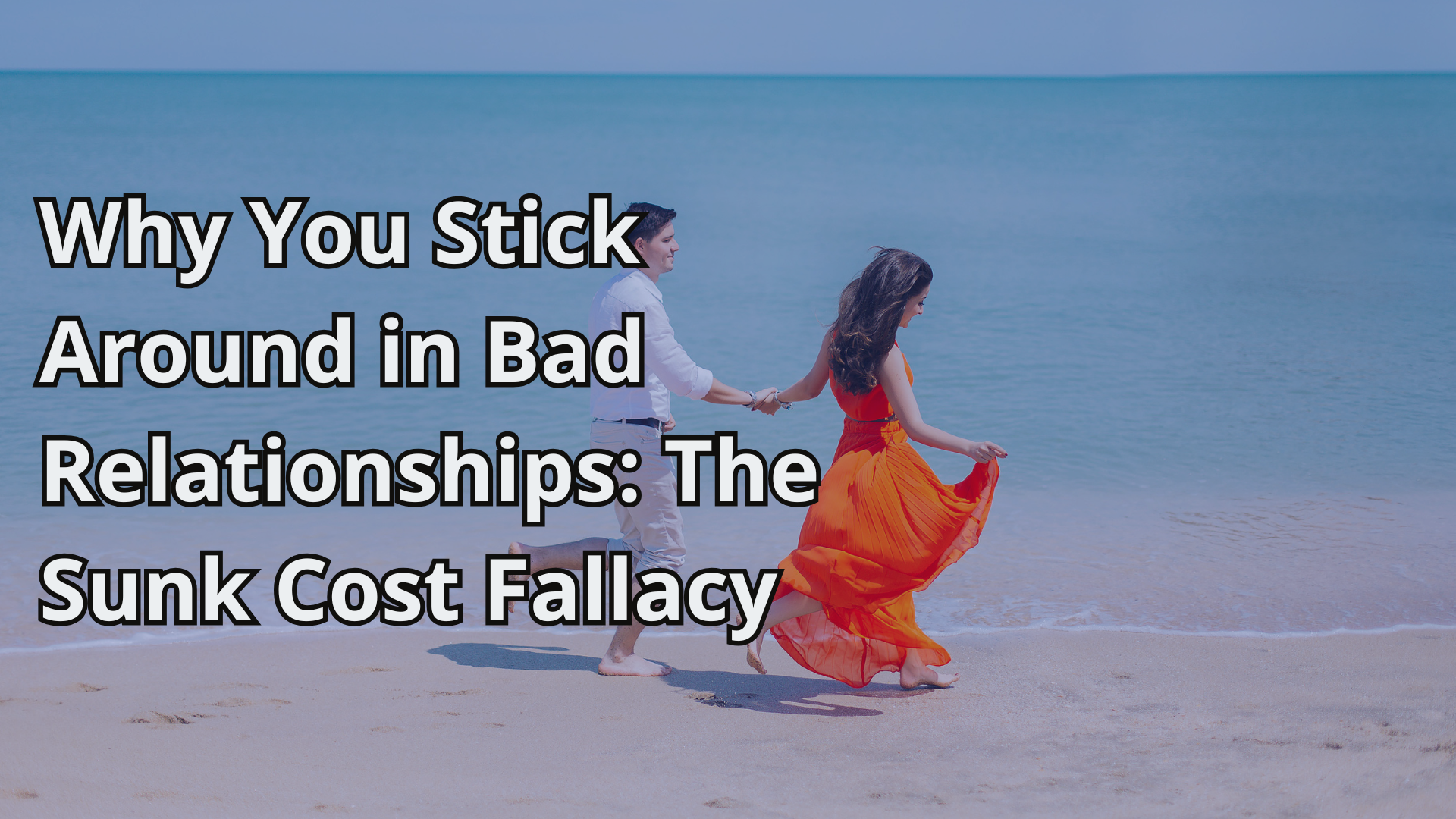Hi, I’m Dr. Peggy Bolcoa, a licensed marriage and family therapist with over 20 years in the field. I’ve helped countless people sort out their love lives, from fresh daters to long-married couples. In my practice in Costa Mesa, California, I focus on what makes bonds strong or what breaks them down. Today, I want to talk about something I see all the time: the sunk cost fallacy in relationships. This trap keeps folks in unhappy spots just because they’ve put in time, effort, or feelings already. It’s like throwing good money after bad, but with your heart on the line.
Think about it – you’ve spent years with someone, shared big moments, maybe even built a home together. Walking away feels like losing all that. But here’s the truth: those past costs don’t change the now or the future. In this article, I’ll break down what sunk cost fallacy relationships look like, why they happen, and how to break free. I’ll share tips from my work, some real stats, and stories from couples I’ve seen. If you’re in a sunk cost relationship, this might help you see a way out.

What Exactly Is the Sunk Cost Fallacy in Relationships?
Let’s start simple. The sunk cost fallacy happens when you keep going with something because you’ve already sunk resources into it – time, money, emotions – even if it’s not worth it anymore. In business, it’s like keeping a failing project alive. In love, it’s staying in a relationship that’s gone sour just because you’ve invested so much.
I first learned about this in my training at Chapman University, where we studied decision biases. It’s a common trap. A study from the Journal of Risk and Uncertainty shows how people favor the status quo due to loss aversion – hating to lose what they’ve put in more than gaining something new. In relationships, this means you ignore red flags because admitting it’s over feels like wasting years.
In sunk cost fallacy relationships, folks say things like, “We’ve been together for 10 years; I can’t quit now.” But those 10 years are gone – sunk. What matters is if the next 10 will be happy. I see this in my office weekly. One client, after five years of dating, realized her partner wouldn’t commit to marriage. She stayed because of all the trips and memories. That’s classic sunk cost relationship thinking.
And in online dating? It’s everywhere. You spend hours swiping, chatting, and going on dates with someone from a site. Even if the spark fades, you keep at it because of the time invested. A piece on PositivePsychology.com explains how emotional attachment amps this up, making it hard to cut ties.
Stats back on this. Research suggests the average person thinks about divorce for 2-3 years before acting, and many stay unhappy for over five years due to sunk costs. In one study on committed relationships, prior investments led to sticking around even when it wasn’t the best choice. Men seem more prone in dating scenarios, as a recent psych study found, because they invest resources to secure mates.
As I often tell my clients, “The goal is to build from the core, not patch up cracks forever.” If it’s a sunk cost fallacy marriage, where vows and kids are involved, it’s even tougher. But staying miserable helps no one.
7 Clear Signs You’re in a Sunk Cost Relationship
How do you spot this? Here are seven signs I see in my practice. If a few ring true, it might be time to rethink.
- You focus on past good times more than current issues. Reminiscing about the honeymoon phase while ignoring daily fights? That’s pining for sunk costs.
- Effort is one-sided. You’re the only one suggesting therapy or dates, like in the Oprah Daily article where one partner gives up.
- Fear of starting over keeps you put. The thought of being single or dating again scares you more than the unhappiness now.
- You justify bad behavior. “He’s like that because of his job,” you say, to avoid admitting the investment was wrong.
- Social pressure weighs heavy. What will family think if you split after so long? A study in Advances in Management Accounting talks about rationalization in decisions.
- No growth happens. You’ve talked about problems for years, but nothing changes. Yet you stay because of the time spent talking.
- In online dating, you keep messaging someone dull because you’ve already shared personal stories.
If you nod to these, you’re likely in a sunk cost relationship. Don’t beat yourself up – it’s human. But awareness is the first step.
3 Big Reasons the Sunk Cost Fallacy Traps Us in Bad Bonds
From my years as a therapist, and backed by research, here are three main reasons we fall into this.
First, fear of hurting the other person. A Forbes piece notes how we stay to avoid pain for our partner, especially if they seem dependent. In my work, I’ve seen spouses delay divorce because “it would crush him.”
Second, slim pickings elsewhere. If alternatives look bad, we stick with what we have. Studies show we rate our partner higher to justify staying. In dating apps, if matches dry up, you cling to the one ongoing chat.
Third, attachment styles play a role. Anxious types fear rejection and stay to avoid abandonment. I use EFT to help rework these patterns.
These reasons mix with loss aversion, where losing feels twice as bad as gaining, per psych insights.
How to Overcome Sunk Cost Fallacy: 6 Practical Steps
Breaking free isn’t easy, but it’s doable. Here’s how I guide clients.
- Get aware. Label it: “This is sunk cost thinking.” A Harvard Business Review quiz can help spot your bias.
- Look forward. Ask, “Will this make me happy in a year?” Focus on future gains, not past losses.
- Weigh costs and benefits now. List pros and cons without old investments. If cons win, it’s time.
- Seek outside views. Talk to friends or a therapist. What would you tell a pal in your shoes?
- Learn from it. As Monica Berg says, energy isn’t wasted – it teaches you what you want next.
- Start small in dating. If online, set limits: after three bad dates, move on.
In sunk cost fallacy marriage cases, therapy helps. I’ve seen couples turn around, but sometimes parting is best. Remember my quote: “I’ve seen seemingly impossible situations become loving, safe, and intimate.”
Stats show therapy works – couples who go see 70-80% improvement, per some sources. But if it’s sunk, better to cut losses.
Stories from My Couch: Real Cases of Sunk Cost Fallacy Relationships
Over 20 years, I’ve worked with hundreds of couples. Here are a few anonymized stories that stick out.
Take Sarah and Tom, together 15 years, married 10. They came in because fights never stopped. Sarah said, “We’ve built a life; kids, house – can’t throw it away.” Classic sunk cost. We dug into attachments using EFT. Tom had an anxious style, fearing loss. After months, they saw the pattern. They split amicably, and both found happier paths. Sarah later dated online and met someone new.
Another: Mike, in his 40s, stuck in a dating rut. He’d been with Lisa for three years, mostly online at first. “I’ve put so much into this,” he said. But Lisa ghosted often. We worked on his optimism bias. He broke it off and tried new sites – found a match quickly.
Then there’s a tough one: an abusive case. Jane stayed because of 20 years invested, despite emotional harm. A study on abusive relationships shows sunk costs keep victims in. We focused on safety first. She left, rebuilt, and now thrives.
In my role as former Clinical Director at The South Coast Center, I handled group sessions where folks shared sunk cost tales. One guy said, “I stayed married five extra years for the wedding costs alone.” Numbers matter – research says men show stronger bias in mating.
These cases taught me: no situation is hopeless, but clinging to sunk costs blocks growth. As I say, “The goal remains: to strengthen the relationship from its very core.” But if the core is cracked, build a new one.
Why Sunk Cost Fallacy Hits Online Dating Hard: 4 Key Ways
Online dating amps the sunk cost game. You invest time in profiles, endless texts, video calls. Here’s how it plays out.
- Profile perfection trap: Hours tweaking your bio, then you match and chat forever, even if it’s flat.
- Ghosting guilt: After weeks of messages, you feel obligated to meet, ignoring gut feelings.
- App hopping hesitation: You’ve paid for premium on one site, so you stick, missing better options.
- Virtual investment: Shared secrets online feel like big sunk costs, hard to walk from.
In my articles, I warn about this. Stats? Online daters spend an average 5-10 hours weekly, per some reports, leading to burnout and stuck bonds.
To beat it, set rules: limit chats to a week before meeting, or delete unmatched convos.
5 Stats That Prove Sunk Cost Fallacy in Relationships Is Real
- 60% of people in unhappy relationships stay due to time invested, per a Decision Lab survey.
- In abusive bonds, sunk costs explain why victims linger, as a ResearchGate study found.
- Men show 20-30% more sunk cost bias in dating, from evolutionary psych research.
- Couples contemplate split for an average 2 years before acting, per divorce stats.
- Anxious attachment boosts staying by 40%, per Forbes insights.
These back what I see daily.
Gender Differences in Sunk Cost Fallacy: Why Men Often Hang On Longer
Guys in my therapy room often hold tight to bad fits longer than gals do. This shows up clear in sunk cost fallacy in relationships, where past efforts cloud judgment.
Research spells it out. A PsyPost study points out men ramp up their sunk cost bias with romantic hints around. It ties back to old survival stuff – men used to lay out resources to snag partners, so now they hate to bail.
In my sessions, this pattern pops up a lot. Take Alex, a client who chased a woman from Eastern Europe on SofiaDate. Months of video calls, and he ignored value clashes. “Plane tickets bought, phrases learned,” he kept saying. Stats say men push on 20-30% more in these spots, especially with cash or sweat involved.
Women handle it another way. They factor in feelings but drop out quicker if the road ahead looks rough. This split means men stretch unhappy ties longer, building up bitterness in sunk cost relationships.
Here are four signs men fall into this trap harder:
- They tally up dollars spent on dates or trips as reasons to stay.
- Fear of fresh starts hits them strong, per Forbes on attachment types.
- Online chats drag on because they’ve shared guy stuff like work wins.
- In marriages, shared stuff like homes keeps them locked in sunk cost fallacy marriage mode.
If this sounds like you, fellas, flip the script. Ask: “Does this fit now, or just because of old stuff?” I tell clients, “Your go-getter side is gold – point it ahead, not back.” Spot it early, and studies show you slash the bias by 40%.
In my Costa Mesa practice, this shift has freed many men. They jump to better spots, often via international sites for new vibes. Past costs? Let them sink. Your love life waits.
The Dark Side: Sunk Cost Fallacy in Abusive Relationships and How to Escape
Time to hit a tough spot I see too much as a psychotherapist: sunk cost fallacy in abusive ties. Folks, mostly women, hang in harm’s way over years poured in, feelings, or family built. It’s gut-wrenching in sunk cost relationship cases.
Data drives it home. A ResearchGate look at 267 women found those paired up sink 434 days average into bad scenes, versus 179 for singles – even with mind games at play. They stuck similar times in calm or emotional abuse, but bailed faster on physical hits. F-stats like 3.98 nail the trend.
87% in that group had partners, pumping up the stay bias. In my work, a 12-year couple rolled in; the wife took emotional shots because “family built, career ditched.” Pure sunk cost thinking, where old gives trump current hurt.
Online dating sneaks this in too. Chats start on a LatiDate, secrets swap, then control slips out. Clients ignore possessive texts because “daily talks for months.”
Some push to quit dead ends for head health – stats show long hauls spike depression 50%. Folks chew on splits 2-3 years average, but many drag unhappy over five. Abuse makes that wait risky.
My words to them: “Your health isn’t sunk; it’s gold.” Here’s five steps to flee sunk cost fallacy in these binds:
- Spot signs early: control, put-downs, isolation.
- Build a net: pals, hotlines, pros.
- List risks now: health hits, kid effects.
- Grab therapy or legal aid fast.
- Post-break, pick safe sites with checks for new starts.
15% pack high-conflict vibes, so screen tight. I’ve flipped “trapped” to “out” for loads. In sunk cost fallacy marriages with hurt, exit wins, not fails. Value tomorrow’s you over yesterday’s work. If it rings, call – I’ve got your back.
Final Thoughts: Break Free from Sunk Cost Fallacy as a Psychotherapist’s Advice
As Dr. Peggy Bolcoa, with my PhD and LMFT license, I’ve spent decades helping folks escape sunk cost traps. It’s not about quitting easy – it’s about choosing joy. If you’re in a sunk cost fallacy relationship, remember: past time doesn’t dictate future happiness. Use the steps I shared, seek help if needed. In my practice, I’ve turned “impossible” into loving bonds, but sometimes that means letting go.
If online dating calls, try SofiaDate, SakuraDate, and LatiDate for fresh starts. As I always say, “Rest assured, we will deal with all problems.” You deserve a bond that’s safe and full of life.
FAQ
How do I spot if I’m in a sunk cost relationship?
Signs: Obsess over past good times, ignore current issues; fear starting over; justify bad behavior. Medium notes tallying sacrifices as a flag. In apps, keep dull convos alive due to shared info.
Does the sunk cost fallacy show up in marriages too?
Yes, in sunk cost fallacy marriage, vows and shared life trap you. Divorce stats show people linger 2-3 years mulling splits over investments. Clients cite “built life” but miss daily joy.
How can I overcome the sunk cost fallacy?
Label it, focus on future happiness, list current pros/cons. Seek therapy or advice. Arootah suggests questions like “Aligns with goals?” For daters, limit chats to a week max.
Is it sunk cost fallacy or real love keeping us together?
Real love brings current joy, not just past ties. If measured by sacrifices, likely fallacy per Medium. Check if it feels safe today; Reddit warns against ditching stable bonds lightly.
What if my sunk cost relationship turns abusive?
Prioritize safety and exit. Sunk costs trap victims in emotional abuse. Build support, seek help. Online, watch controls early.

